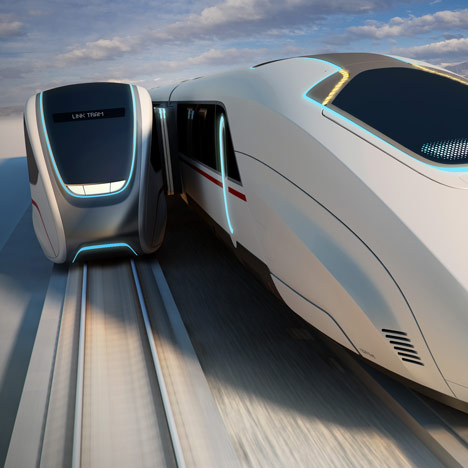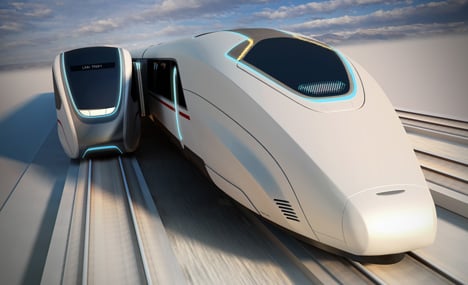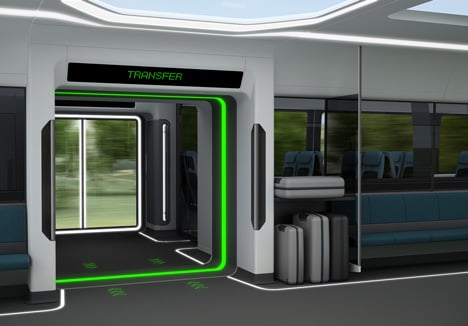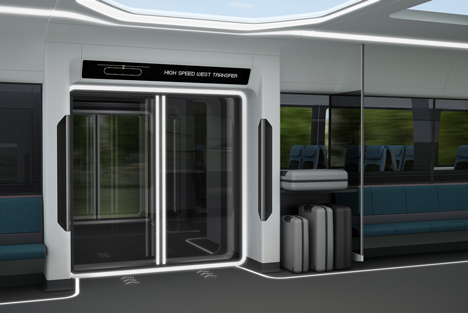Moving Platforms by Priestmangoode
Industrial designers Priestmangoode have revealed a concept for high-speed trains that would transfer passengers to local services while still moving, instead of stopping at stations.

By avoiding time-consuming stops, the Moving Platforms concept would allow faster long-distance journey times.

Trams and local trains would dock alongside the high-speed trains while still in motion, allowing passengers to walk between the two services.

As part of a fully integrated network, passengers would be able to journey from a local stop to any international destination without disembarking.

More stories about Priestmangoode on Dezeen »

More transport design on Dezeen »
The following details are from Priestmangoode:
Britain’s leading transport designer unveils the future for 21st Century train travel
Britain’s leading transport designer has unveiled his idea for the future of train travel. Moving Platforms is a completely inter-connected rail infrastructure where local trams connect to a network of non-stop high speed trains enabling passengers to travel from their local stop to a local address at their destination (even in another country) without getting off a train.
Paul Priestman of Priestmangoode is the designer of the Virgin Pendolino train and last year’s hugely successful Mercury high speed concept train. Moving Platforms is a totally joined-up network that allows passengers to transfer directly from one moving tram or high speed train to another. This new integrated infrastructure mimics the way the internet works, creating a system similar to the one that allows your home PC to connect to a computer on the other side of the world via a series of connected networks.
Moving Platforms involves a network of high speed trains that run non-stop between two ends of a continent, New York to San Francisco for instance. The high speed trains run on a line that passes outside towns and cities with a network of local feeder trams that carry passengers from local stops out to meet them. As they near each other, the high speed train slows down slightly and the tram speeds up alongside it, at which point the trains physically connect via a docking system allowing passengers to transfer directly across from the tram to the high speed train and vice versa. Once transfers are complete, the trains separate, with the high speed train speeding up again along its route, and the tram slowing down and going back into the town or city centre with the newly disembarked passengers. The tram, in effect, acts as a moving station. The same system could also be used by passengers transferring from one high speed train to another.
This idea is not as crazy as it sounds. There are plenty of examples in every day life where we step onto a moving vehicle: escalators, moving walkways, paternoster lifts, ski lifts and Ferris wheels like the London Eye.
We are trying to build a new 21st Century train service on a station-based infrastructure that was designed in the 19th century for steam trains. We should be re-thinking infrastructure and building an inter-connected local-to-global rail network.
Current plans for high speed rail will require a new network of major stations, taking up huge amounts of space and with a cost and environmental impact that is potentially vast. These stations function for the most part as large car parks that are packed during working hours and empty the rest of the time, and are only in use by passengers for short periods of the day.
The big problem with high speed trains is that they are not very fast. Slowing down and speeding up as they move between stations means they are only able to travel at their full speed for limited periods of time (wasting vast amounts of energy in the process). On long journeys, the non stop high speed train could save a vast proportion of any journey time.
We lose huge amounts of time in transit waiting at stations as we change trains. Moving Platforms would enable passengers to travel from their local stop to an address of their choice in another town or country without getting off a train.
Many rail passengers use cars to get to their main-line embarkation station, so being able to link up to the high speed train directly from a local tram or train service means we could reduce car usage in towns and cities.
Track infrastructure is already in place in many areas. On each train line, there are two tracks, one high speed and one local, next to one another. This means that potentially, Moving Platforms would not take up any more land.
Existing local stations would serve the feeder trams, enabling passengers from rural areas to access the high speed line easily.
Moving Platforms could also be used for local deliveries and freight. This will help get trucks off the road and ease congestion on motorways and in towns and cities.
A journey planner App would tell you what local tram or train to get on in Boston to go to a local address in San Francisco for instance, making travel simpler and easier.
“I can’t believe that across the world we are spending billions on high speed rail making it run on a network that was invented in the 19th Century. I’m under no illusion that Moving Platforms is a big idea, but if we really want high speed rail to be successful and change the way we travel, getting people off the roads and reducing the number of short haul flights, it is imperative that the infrastructure we use works with, not against, this new technology to enable a seamless passenger journey from start to destination. The days of the super-hub train station are over, connectivity is the way forward,” says Paul Priestman.